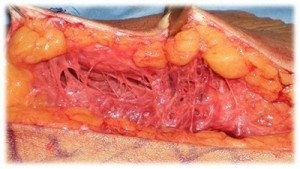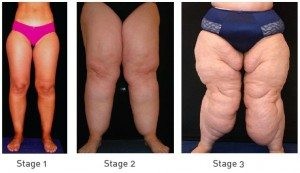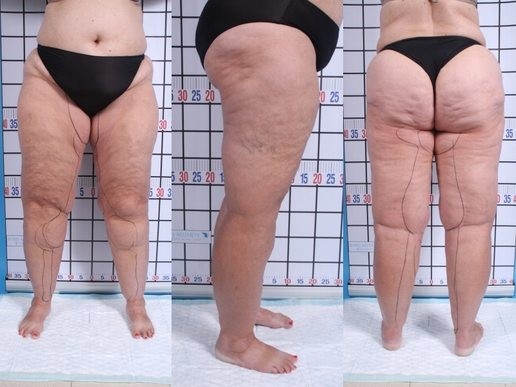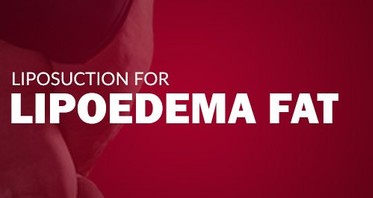Jasna Tursic, 45, had spent 12 years in constant pain without ever knowing the cause. Her life changed dramatically, however, after she was diagnosed with Lipoedema, and the treatment turned out to be liposuction.
What is Lipoedema?

Lipoedema (also called lipedema) is a chronic condition that almost exclusively targets women. Early stages can be seen in puberty, although it can also occur post-pregnancy and during peri-menopause. Gynaecological surgery or extremely stressful situations can also trigger the condition.
There seems to be a family history, and is caused by an overgrowth of fat deposits in women of all body shapes and sizes, from the incredibly lean right through to those struggling with morbid obesity. Lipedema patients endure devastating effects on the legs (and occasionally the arms), ranging from tenderness to in extreme cases, immobility.
The diseased fat cells form a unique and unusual shape, normally from the waist down, to a clear and obvious line in with the lower legs, above the ankles in a bilateral, symmetrical shape. Beverly Hills Dr David Amron told FoxNews.com that the disease is “very specific to circumferential calf to ankle swelling…(with) heaviness on top of the knees, giving legs a tree-like look to them.”
Lipoedema misdiagnosis is common

Unfortunately for Ms Tursic, her initial diagnosis of lipedema was incorrect. Doctors actually mistook her condition for Lymphedema. While the two conditions are similar in that there is unnatural swelling of adipose tissue at the extremities, Lymphedema is linked to malfunctioning of the lymphatic systems that causes fluid retention, not growth of fatty tissue.
A clear sign of Lipoedema, that possibly should have alerted the doctors who misdiagnosed Ms Tursic, is that the feet are not affected, which is a typical side-effect of Lymphedema.
The outlook was not favourable for Ms Tursic. Her doctors predicted a progressive decline, culminating in her eventually becoming wheelchair bound. The lipedema fat was causing her so much pain that she underwent five separate surgeries for Lymphedema and wore compression garments for three years.
Despite changing her diet, exercising regularly and spending a lot of money on supplements, Ms. Tursic’s quality of life did not improve as the chronic pain persisted. Ms Tursic did not realize that although weight loss through diet and exercise may decrease subcutaneous fat, it has little effect on decreasing the amount of lipoedematous tissue in the body.
Light at the end of the tunnel

After consulting a local Utah cardiologist in March of 2012, she was finally correctly diagnosed with the fat disorder called Lipoedema. Ms Tursic was told the best way to relieve the pain was to remove the excess diseased fat by undergoing liposuction, a common cosmetic procedure.
While there now seemed to be a light at the end of the tunnel, this diagnoses created new complications. If the procedure was unsuccessful, damage to the blood vessels, connective tissue and lymphatic system was a real possibility. In other words, this lipedema treatment could potentially make her chronic pain and other related symptoms even worse. As such several liposuction doctors refused to perform the liposuction procedure.
Finally, Ms Tursic met Dr Amron, who agreed to help.
“I was crying and said, ‘You are my last hope! Please do your best,” she said.
The day after the procedure Ms Tursic was on her feet, and her life has improved drastically since. She is off painkillers, isn’t fearful of a future life in a wheelchair as was predicted by her doctors, and exercises regularly at her local gym.
Other common treatments for Lipoedema
There is no uniform, universally accepted treatment options for Lipoedema. Conservative treatments recommended by Lymphoedema doctors include: Manual lymphatic drainage, bandaging, followed by compression therapy (wearing a custom-fitted compression garment).
For some people wearing compression garments and manual lymph drainage can reduce the pain caused by Lipoedemic fat; however, this didn’t work for Ms Tursic. In Ms. Tursic’s case, conservative therapy appeared to have limited effectiveness in managing her lipoedema symptoms.
Some women have seen a positive result in the reduction of pain and reversing Lipoedema without surgical treatment. It involves starting an elimination diet, low impact exercise regime and a herbal course of action to combat the inflammation. In Australia and throughout Europe this course of lipedema treatment has been gaining momentum.
Cosmetic surgery can be used to treat medical conditions
Liposuction, beyond its common perception as a cosmetic procedure, may offer medical benefits in certain cases. In Ms. Tursic’s experience, her symptoms have been managed effectively post-procedure, with a current absence of lipo-lymphedema and chronic pain symptoms. All follow up appointments show no need for additional lipedema surgery.
“(The surgery) changed my life so much,” she said.
A growing number of doctors across America and Europe have been using gentle water-jet-assisted liposuction, (also called tumescent liposuction) combined with local anesthetic, to treat Lipoedema. Water-assisted liposuction removes Lipoedemic fat while protecting the lymphatic system.
Related post







8 thoughts on "12 Years of Leg Pain GONE Thanks to Liposuction"
I have lipoedea and just read your article. Am interested to know how i too can get liposuction.
Hi Kelly,
Thank you for your enquiry.
Here at Cosmos Clinic we are experienced in treating patients who suffer from Lipodema using Liposuction technology. We do recommend a consultation with the doctor so that he can accurately assess the area that is of concern to you and give you an idea of the results that you could expect to achieve.
Our most popular Liposuction method is Vaser Liposuction. Vaser uses Ultrasonic energy to melt the fat cells making it easier to remove the fat cells via liposuction. Not only will Vaser Liposuction remove stubborn fat cells but it is a truly incredible development in getting the physique you are striving for. It is performed under mild sedation, so are much safer than procedures where general anaesthetic is used. Patients are able to stand up during the procedure to enable us to sculpt you accurately and can go home that day. Most of our patients are back to work within 1-3 days.
To give you an idea of pricing the cost of these procedure’s start from $4400 with each additional area costing $1750. Please find below a link to our website with more information on this procedure.
https://www.cosmosclinic.com.au/liposuction/before-after/
https://www.cosmosclinic.com.au/liposuction/vaser-liposuction/
Please don’t hesitate to call or email if you have any further questions or if you would like to book an appointment.
Hope this helps!
I’m 52 years old just Dx with lipidema , I’m interesting in the surgery please let me know what I need in order for me to have it done ? Thank you
Hi Lena, send an email over to [email protected] and we can discuss from there, or give us a call on 130 138 797 to discuss your next step! 🙂
Is there someone in Brisbane/Gold Coast area who can do this. I need help now and don’t care what it costs I just can’t travel to Sydney Melbourne or Thailand etc
Hi A T,
We are so sorry to hear you are struggling with this issue. We do have a clinic on the Gold Coast who can help you. Please call us on 1300 138 797 and select our Gold Coast clinic to book in a consult.
Hi
Do you have your own doctor at each clinic or do we have to see a general GP for lipodema or similar, I doubt where i see my GP that they know much about the disease as they don’t know much about other issues that I had in the past and they were a lot more simple?
Thanks in advance for your time.
Hi Jasmine,
We have a doctor at each clinic. We have a clinic in Sydney, Canberra, Adelaide & Gold Coast. Call us 1300 138 797 to organise a consultation. Good luck Jasmine.
Comments are closed.